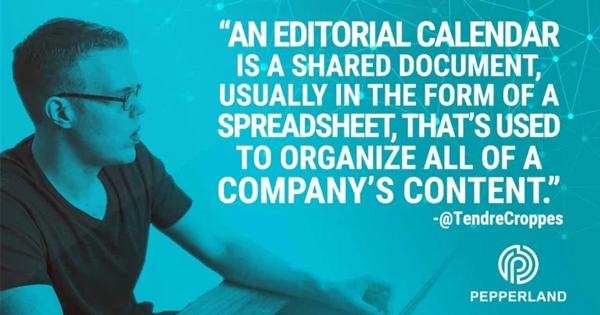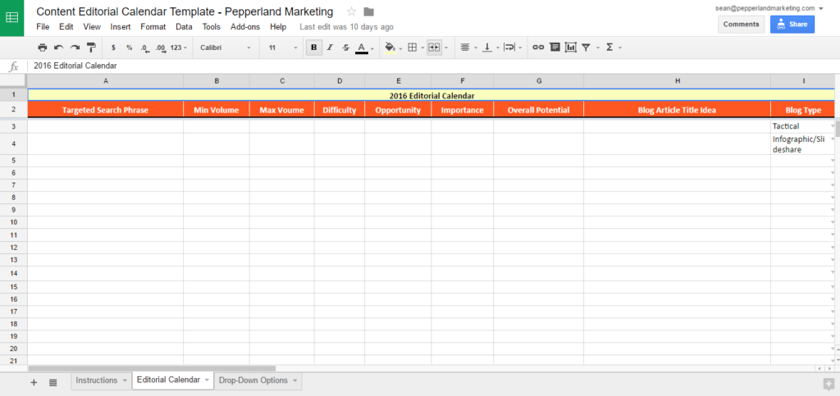Written By:
Will Purcell
What is an editorial calendar? Does a school really need one to create content? Chances are you’ve at least heard about an editorial calendar, but if you’re not a part of a marketing team, do you really need to understand what this document is?
In this article, we address these questions by:
- Defining what an editorial calendar is
- Explaining what it looks like
- Detailing why a school needs one
Marketing teams in higher education and independent K-12 schools are constantly searching for new content to help boost their school's reach.
However, an editorial calendar can be leveraged for more than just content. To find out how, we spoke with Tim Stobierski, Senior Content Specialist at Pepperland, and discovered why exactly a school cannot afford to create content without one.
What is an Editorial Calendar?
An editorial calendar is a document that organizes and structures content in one centralized place.
The key factor for an editorial calendar is that it allows collaboration between multiple offices within an institution.

So, where do I start? Do I use a calendar app, or a shared drive to create an editorial calendar?
For the best results, we recommend using Google Sheets because it allows organizations to collaborate and freely share documents, which can also link to other sheets in different files as well.
An editorial calendar doesn’t have to be in the form of a spreadsheet, but using a shared document like Google Sheets helps eliminate any confusion or common styling issues people run into when viewing and sharing documents across multiple platforms and software.
Free Download – Editorial Calendar Template
What does an editorial calendar look like?
For an example of what an editorial calendar might look like, reference the graphic below.

It’s important to note that an editorial calendar is typically used exclusively for marketing content like a school blog. You can use it for other types of content as well—such as website pages, landing pages, content offers, etc.—but if you do, we recommend separating them with their own tabs to maintain the best organization.
What should I put into an editorial calendar?
Generally speaking, all editorial calendars will include the type of content and a few basic details about it including:
- The headline
- Publish date of previous/upcoming content
- An author
- An editor
As you can see from the graphic above, an editorial calendar can and probably should include a few other materials to render the best results for content.
“We recommend adding more fields in an editorial calendar because each piece of content is tied to a specific institutional goal,” said Tim. “When we plan content we include the keyword, status, fields for the attached campaign, the content offer (download), the persona we’re targeting, and the business segment of the targeted audience.”
Let’s break down that quote a little further — an SEO driven editorial calendar will include:
- Keyword: The search term or phrase your optimizing content for
- Status: Is the article planned, in progress, or published?
- Campaign: What marketing campaign is this piece of content tied to? This helps to measure results throughout a campaign.
- Content Offer: The related offer, which will appeal to your target audience and progress them further along the buying cycle (buyer’s journey)
- Persona: Specifically, who the article is targeting
These fields and specific metrics can, and probably will differ from school to school, even within the same industry. However, the general guidelines remain the same. Identify your keyword, attach that keyword to the corresponding campaign, and develop content for the targeted persona.

Why do I need an editorial calendar? [3 Reasons]
So we’ve talked about what an editorial calendar is and what it entails. But, why exactly do you need one? Can’t you just create content and post it to a website? Why does your school need a “shared document”? After all, can’t the marketing team handle that? Why do other departments need to be included in content planning?
As Tim mentions, an editorial calendar is more than just a simple document — it makes your content goals and ideas real — here’s how.
1. Organization and Scheduling
At its core, an editorial calendar functions as an organizational tool that helps organizations plan for upcoming content and marketing campaigns.
But, it’s not just about organizing future content, as Tim explains. “An editorial calendar serves as a library for all of your content.”
“You not only know what’s coming up, but you can also use it to go back into older content and run different audits to find out what areas of a campaign were, or were not successful.”
Without an editorial calendar, this type of transparency and structure simply would not be possible.
2. Enhanced Communications
Simply put, an editorial calendar is self-serving for a marketer or marketing campaign.
For example: If your boss or superior were to ask you for a list of completed tasks from the last quarter, could you answer in an accurate and timely manner?
For marketers, publishers, or any content creators, an editorial calendar is an easy and effective way to answer this question. That’s because it gives a clear view of:
- What has been posted
- What’s currently being created
- What’s scheduled for the future
Tim further explains the value here, “It’s a way to keep shareholders in the loop about all content marketing efforts.”
Ultimately, this helps to keep everyone on the same page with a more transparent and effective line of communication between you—the content creator—and shareholders.
3. Admissions Enablement
A marketing team isn’t the only department in a school that uses content.
For example, think about your admissions pipeline.
Do you have an easy-to-access method of answering your prospect’s questions? What about resources? Does your school have a helpful database of information that can be shared quickly? Or, do you have to rewrite information to prospects each time they ask a question about your services?
Generally speaking, when it comes to building trust with your internal stakeholders, the more information the better.
That’s why maintaining an editorial calendar is a great way to seamlessly share information with internal team members in a timely fashion, as Tim explains.
“Essentially, an editorial calendar is a repository,” he said. “Having all your content in one, accessible place can help a admissions office use your content to educate prospects, nurture inquiries, and yield applicants.”
“Even if you’re not a content creator or editor, you can use an editorial calendar to find a relevant blog post, send it to a prospect, and answer their questions without wasting time rewriting information from scratch.”
Essentially, an editorial calendar makes content readily available at the click of a button in one universal location, which increases admissions enablement while building trust with prospective families.
Get Real Results Using an Editorial Calendar
Virtually every stakeholder will want some form of proof when it comes to investing in an idea, plan, or campaign. That’s why adding information to an editorial calendar can only strengthen the relevancy of your content.
“Especially for schools just getting started with blogging, a marketing department can struggle getting buy-in from the admissions office and stakeholders,” said Tim. “That’s because there’s no proof of keywords or successful results that showcase why stakeholders should care about helping you.”
He continues, “The more you can do to make your content feel real, the better.”
Ultimately, an editorial calendar helps create a comprehensive process for content. By aligning dates, products, and services to each article, you can bridge the gaps between content creators and stakeholders.
Are you ready to strengthen your school's outreach through effective, measurable content? Start by downloading our FREE editorial calendar and plan for success in your next marketing campaign!







